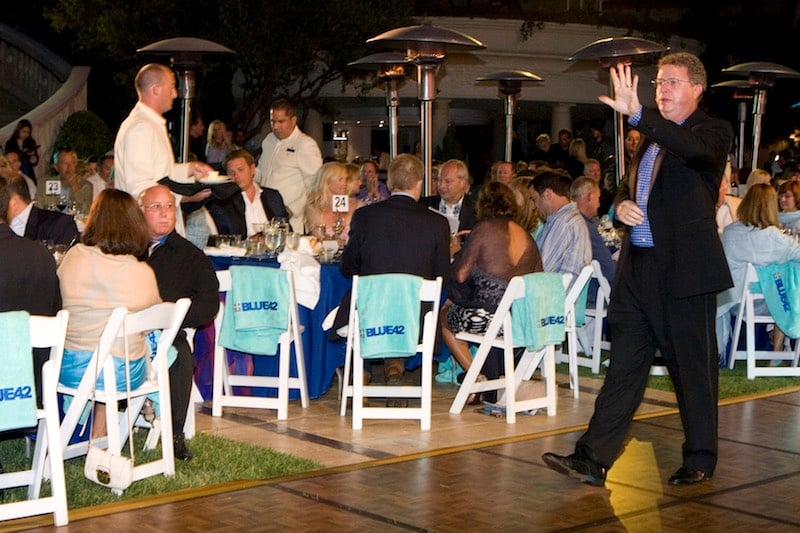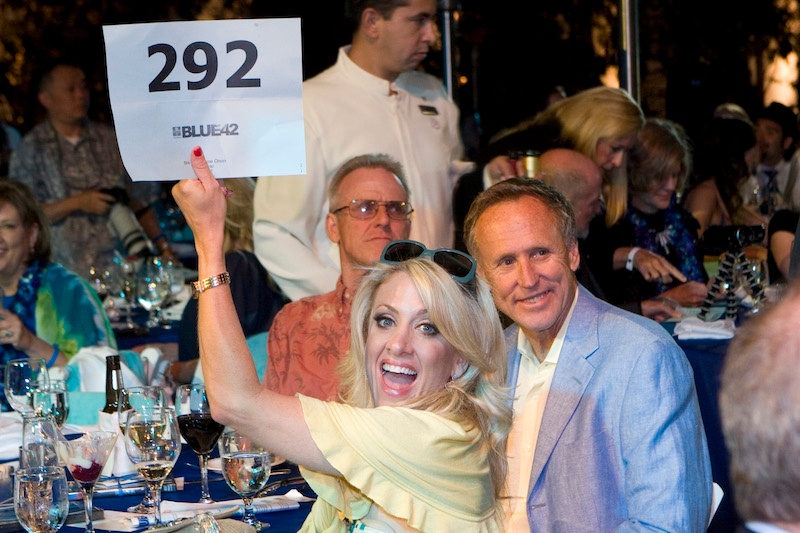What’s the best way to arrange seating in a live auction? As always, it’s imperative to think like a pro when planning a fundraising event.
Today we’re going to look at how a benefit auctioneer would approach one often-overlooked aspect of running a charity auction: reserved tables and seating arrangements.
Specifically, we’re going to look at a seating concept called the “triangle of influence.“
In a recent webinar, auctioneer Scott Robertson shared how the way the audience is arranged can be the difference between meeting your goals and falling short. Read on for tips to maximize auction seating to raise more for your cause.
 What is the ‘triangle of influence’?
What is the ‘triangle of influence’?
The ‘triangle of influence’ in a charity auction refers the strategic placement of major donors at reserved tables front and center, where they can best interact with the auctioneer.
Why do we need a triangle of influence?
Here’s the top 3 reasons why it’s important to create and cater to this special section of the audience.
[1] It makes the live auction easier, and more strategic, for the auctioneer.
The triangle is where the auctioneer can direct his attention most strategically. Guests in this location are most directly in the auctioneer’s line of sight.
While the auctioneer will be scanning the whole room for participants in larger-scale portions like the fund-a-need and raffles, live auction items (if procured correctly) should only cater to the top tier of spenders. Within that triangle is where you’re going to want to put your historic big bidders and donors.
[2] Big donors love to be recognized.
A big reason live auctions pull in more money compared to silent auction is that it’s openly competitive.
“I hear this one all the time. Auction organizers think, ‘Our donors don’t want to be showy. They’ll want to bid anonymously.’ I’ve been doing this for 23 years, on occasion that happens, but for the most part it doesn’t end up being true,” Robertson asserts.
Big donors want to be seen making big bids and contributing generously to the cause!
The best place for them to get that recognition is near the stage.
Auctioneers get the highest bids when they’re able to celebrate donors’ opportunity to bid and create an emotional feeling in the room.
“Success breeds success,” Robertson adds. Putting yourself in the mind of an audience member, they might think, ‘Wow, Joyce, Barb, and Bob donated. Maybe we should give more than we thought we were going to.’
Bottom line: Enthusiastically recognizing donors is always a good idea. Catering the auction to the triangle of influence adds to the fun, competitive atmosphere that makes fundraising auctions successful.
[3] If you don’t reserve tables, people who spend the least get the best seats.
If you don’t have reserved tables at your event, the people who end up taking the best seats are those who actually spend the least!
The reason: People who spend the least are not really participating in the silent auction. As a result, when there’s open seating, they love to take advantage of the opportunity to get prime real estate.
For auction success, you’ve got to keep the focus on fundraising all night. Everyone wants to see the show, but if people aren’t going to bid, it’s not strategic to put those people up front. Give those tables to the high bidders.
{{cta(‘ace6904c-d5a9-4f23-afcc-36e09cf0f71e’,’justifycenter’)}}
How to Set Up the Triangle
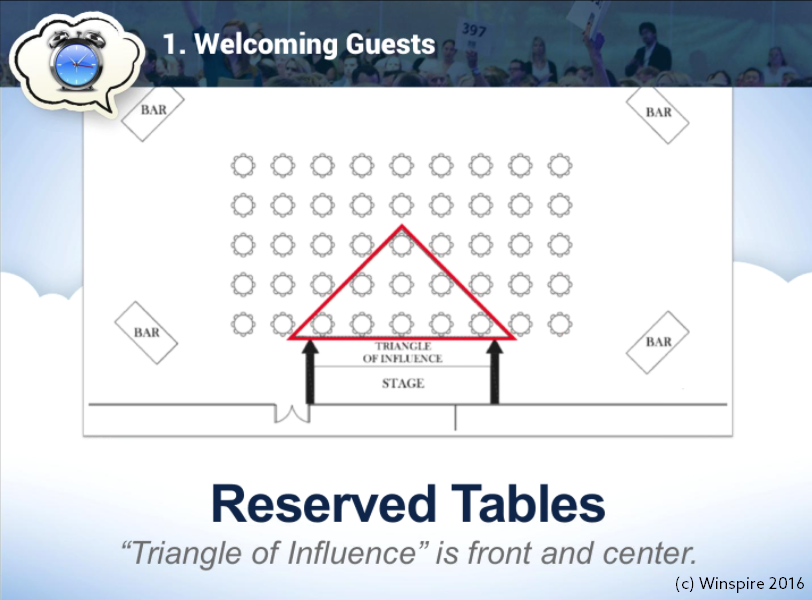
7 More Tips for Success
[1] Remember the best seats may not be in the front row.
The best seats for your event can depend on your venue and auctioneer.
In the diagram shown above, the best table in the house isn’t necessarily right up front. Unlike “courtside seats” at a basketball game, front row seats end up being too close. The peak of the triangle, a table a few rows back, may actually a better seat from a fundraising standpoint than the edges of the front row.
[2] Work with your auctioneer.
The key to a lucrative triangle of influence is determining which seats are most in your auctioneer’s line of sight. I suggest asking your auctioneer about her or his auctioneering style. They may like moving around the room but still focus attention on one area. Work together to strategize the placement of the triangle.
[3] Adjust for oddly-shaped layouts.
Here’s a question we got from one webinar attendee: “What about a floor room layout where a dance floor basically splits the room?”
Great question – this layout is very common at charity auctions.
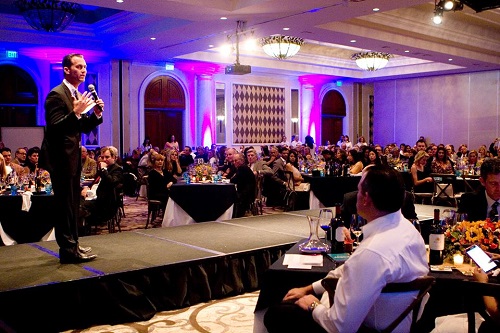
Your triangle of influence has now become a U!
The largest amount of money should be at the end, with tables directly facing the stage. The second tier of money should be the tables behind that row.
“It’s also a great place to put in rectangular tables if everything else is round,” Robertson adds. “It separates out the bigger money from the other money, so that works as well. But you’re going to surround the dance floor.”
He adds that if a dance floor like this is involved in an auction, the auctioneer will work from the dance floor. “Even with 500 people in the room, I’m still going to work from the dance floor. If I have 700 people in the room, I’m going to put a riser in the middle of the dance floor that’s going to be taken down right afterwards so that I can see a little bit better.”
Bonus Tip: Don’t make the dance floor any larger than it really absolutely has to be, Robertson cautions. “It’s valuable, valuable real estate.”
[4] Focus on reserved tables, not seating.
Reserved seating means assigning specific chairs instead of tables. This is a whole lot more work and you never know for sure who will want to sit where, who will arrive when and so forth, so try just assigning tables rather than seats.
[5] Skip sponsored tables.
Event sponsors, and people who historically don’t bid that much, can be placed on the outside fringes.
In a recent webinar, an auction organizer asked, “How do you handle table assignments when 99 percent of event attendees are guests at sponsor tables?”
Robertson replied, “99 percent? I think I wouldn’t hold the event, I’d just get all those sponsors to pony up! Kidding aside, again look at your historic bidders, and see who has been supporting in the past. If it’s XYZ Bank, find out who they’re going to be sending. (You can ask that question, it’s okay to do that.)
“Ask, are your main people going to be there? If they are, sit them up front.
“If they’re not, if they’re going to be sending employees, these guests likely came for two reasons: food and drink. Don’t put them dead center. They’ll be the entertainment, and then they’ll leave early. Nothing is worse than a table that leaves early that is up front, dead center.”
It’s great if sponsors themselves attend the event. If not, accommodating their guests can be a challenge.
{{cta(‘f2a7ad66-bc37-4f6f-ac57-1560c652588b’,’justifycenter’)}}
[6] Remember there are exceptions to every rule.
You might be wondering, What about our honorees? Where is the best place to seat them if they’re not in the triangle of influence?
The answer is, it depends. Their moment in the sun is going to be when they’re on the stage, so put them close to the stage so it’s easy to get them onto the stage. That’s where they’re going to be honored. But they don’t have to have the best seat in the whole house.
There’s exceptions to every rule. If they have star power, maybe you do want to put them at a special table. But mostly you want to make sure the transition is quick. Don’t forget: Every honoree or speaker has to return to their seat. When that’s happening, you’ll want everyone’s focus to be on the next speaker, not on the guest of honor walking back.
[7] Don’t shy away from a pecking order.
Sometimes charities can be shy about ranking donors, but remember to plan, as much as possible, from a fundraising perspective.
“Next year if you have someone who is a high bidder, and they weren’t in that special triangle, move them to the special triangle. It becomes a bit of a pecking order. But we definitely want to reserve the tables where people are going to be. If you have to have open seating, put open seating in the back. It will also help you to sell tables next year,” Robertson advises.
❧❧❧
Bottom line: Success breeds success. It’s why the triangle works so well, Robertson concludes.
“Donors like it better, and you’re going to like it better. Everyone in the room is looking toward the stage, looking toward the auctioneer. They’re going to see those people, and that’s going to make the whole event have a much better feel than if they’re scattered all over the room. So work off of that triangle. Trust me, it works.”
—
To see the full session with Scott Robertson, click below to access our entire webinar library. Portions of this post were taken from Part 2 of his webinar series on auction timelines.
{{cta(‘2c2afed8-70df-494b-8204-3eb3c111af11′,’justifycenter’)}}
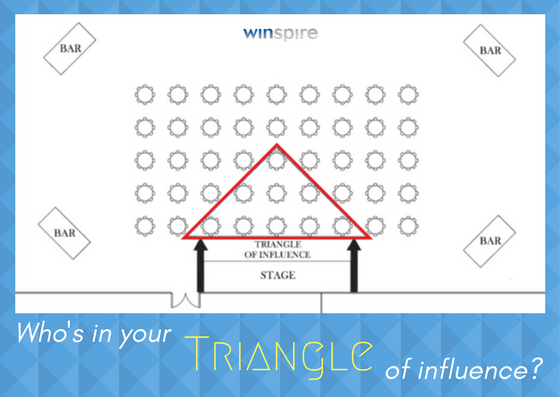
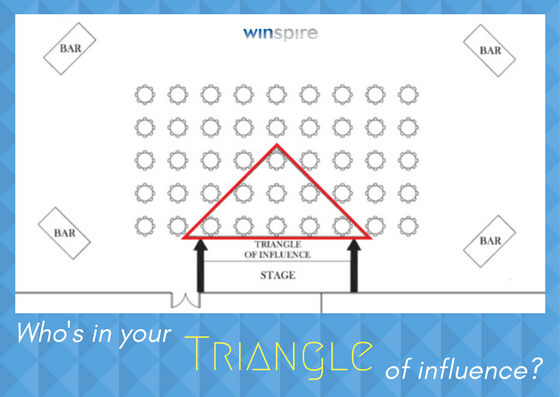
 What is the ‘triangle of influence’?
What is the ‘triangle of influence’?